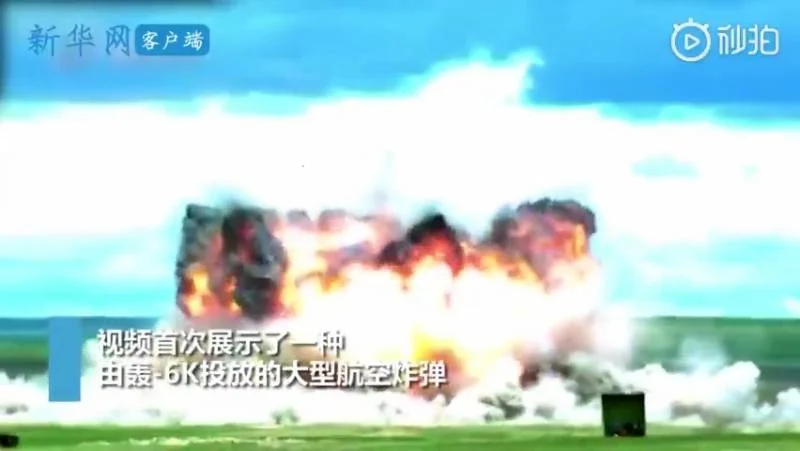The Chinese People’s Liberation Army Air Force (PLAAF) has published a video depicting the airdrop of a new aerial bomb: the “mother of all bombs.” The video was uploaded to the Chinese social network Weibo by the official PLAAF account to commemorate the 73rd anniversary of the organisation’s founding. No other information regarding the new bomb has been revealed.
Wei Dun Xiu, a military analyst, stationed in Beijing, thinks that the video demonstrates the usage of a thermobaric bomb. Based on the explosion’s power, Wei concludes that PLA military engineers had developed their own “mother of all bombs” comparable to the American GBU-43B.
In 2019, a video from the Chinese state-owned business NORINCO leaked online, revealing the presence of such a bomb in the Chinese military for the first time. Even then, observers believed the PLA had tested the largest non-nuclear bomb of Chinese origin.
The Chinese military demonstrated for the first time the devastating potential of its “mother of all bombs.” The main bomber of the Chinese Air Force, the H-6K, can only drop one of them at a time, according to a 2019 article by the Xinhua news agency.
Visible Features
According to public videos, the Chinese “mother of all bombs” is substantial. Additionally, the equivalent mass is assumed. According to reports, only the Xian H-6 bomber can carry and use the bomb, which may reveal its dimensions and weight.
The diameter of the bomb is somewhat smaller than the breadth of the aircraft’s cargo compartment. The length of the product is anticipated to be at least 6 metres, excluding the suspension of two bombs simultaneously. The carrying capacity of the most recent models of the H-6 reaches 10 to 12 tonnes, which is the maximum permissible capacity.
The bomb’s body was shaped simply, typical for unguided weapons. The hull has an ogive head, a cylindrical middle section, and a tapered, stabiliser-equipped tail fairing. In the time between the two displays, the stabiliser’s design has changed, which is surprising. In both instances, there are eight planes, but on the more recent bomb, they are connected by a ring.

The body lacks any steering surfaces. There are no indications of folding rudders either. This indicates that the bomb is ‘free fall’, with its trajectory governed by the combat course of the carrier aircraft and other external factors.
The head fairing is distinguished by a central rod of short length and many protrusions with uncertain functions. Almost certainly, this is a contact fuse target sensor. However, the use of a distant target sensor that gives an explosion at a particular height above the surface cannot be ruled out.
It was unclear what charge was used; however, it was reported that it was not a volumetric detonating warhead. A big bulk of high-explosive fragmentation charge is used, and a mixture of explosives may be employed to achieve maximum power. With open source data, it will not be able to estimate the mass and TNT equivalent of such a charge.
Since the bomb is free fall, the carrier aircraft must approach the target from a distance of several kilometres and enter the potential destruction zone of hostile anti-aircraft guns, exposing itself to recognised dangers. Moreover, the absence of control and guidance systems significantly raises the ammunition’s Circular Error Probability (CEP). Even with the most advanced sighting systems on the carrier, it is extremely difficult to strike a small target. It is possible for the deviation from the target to be so great that even the increased power of the ammunition cannot compensate for it.
Why the PLA’s long-range aviation required such weaponry needs to be clarified. The H-6 bomber’s ordnance load consists of various guided and unguided bombs of smaller calibres, and this terminology is adequate to accomplish all primary combat missions. A multi-ton bomb is not the most successful or essential design compared to existing weapons. Apparently, the PLAAF weighed the benefits and drawbacks of such weapons and determined they were necessary, prompting the NORINCO Corporation to create them. It is unknown whether a multi-ton bomb will be beneficial in actual operations. However, it should be noted that this enhances the variety of available ammunition and the versatility of bomber aircraft.
It should be emphasised that the Chinese “mother of all bombs” was only shown twice. In both instances, she appeared in industrial and military advertisements. Perhaps the one-of-a-kind bomb was designed merely to demonstrate or test the capabilities of industry and long-range flight. Its use outside of demonstration activities is, therefore, not envisioned.
